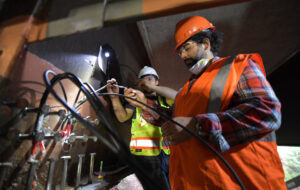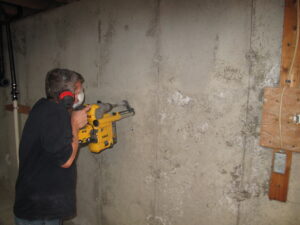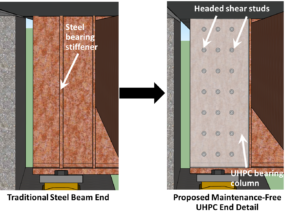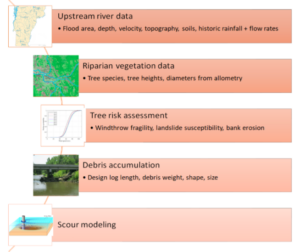
- Structural Engineering and Applied Mechanics
- Transportation and Urban Engineering
- Environmental Engineering
- Connecticut Manufacturing Simulation Center
- Connecticut Transportation Institute
- National Institute for Undersea Vehicle Technology
- Technical Assistance for Brownfields Program
- UConn Eversource Energy Center
Structural Engineering and Applied Mechanics
The Structural Engineering and Applied Mechanics (STAM) group performs multi-disciplinary research in structural engineering, advanced design, structural vibrations, and other related areas. The faculty has expertise in both structural engineering, involving the design of buildings, bridges and other structures, and applied mechanics, which forms the basis of all structural analysis and design.
The STAM group is engaged in cutting-edge research aimed at creating a more sustainable and resilient world. Our faculty have expertise in smart structures, structural health monitoring of buildings and bridges, application of advanced materials, Accelerated Bridge Construction, ultra-high performance concrete, renewable and clean energy harvesting systems, and innovative repair techniques for aging infrastructure. From earthquake engineering and multihazard resilient design, to structures in space and extreme environments, the UConn STAM group is at the forefront of structural engineering and applied mechanics research.
Featured Projects
Viscoelastic Modeling Aided Experimental Optimization toward Fracture-Resistant Porcelain-Veneered Zirconia and Lithium Disilicate Restorations
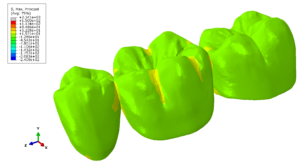 Sponsor: National Institutes of Health (NIH)
Sponsor: National Institutes of Health (NIH)
Principal Investigator: Jeongho Kim
Period: 08/01/2017-07/31/2022
Budget: $663,635
Project Abstract
Dental crowns and bridges are usually constructed by applying an aesthetic porcelain veneer to a strong core material. Ceramic core materials, such as zirconia and lithium disilicate, are currently favored for their ease of fabrication and strength. Chipping and fracture are prevalent in porcelain-veneered zirconia. The high chipping/fracture rate is due predominantly to residual stresses introduced by the high temperature veneering process, but a comprehensive knowledge of the key material, design and processing parameters that govern residual stresses remains absent. The goal of this project is to improve the fracture resistance of porcelain-veneered prostheses through the reduction of deleterious residual tensile stresses and the design of a graded veneer-core interface. The overall objectives are to develop a rigorous viscoelastic graded finite element methodology to guide the design of next-generation fracture-resistant porcelain-veneered ceramic prostheses, and to use clinically relevant fracture mechanics test methods to validate predictions from finite element modeling. The proposed research advances understanding of how stress profiles in all-ceramic prostheses can be tailored for better fracture resistance. Ultimately, such knowledge will bring us closer to a solution of a clinical problem such as chipping, delamination and fracture of porcelain veneered prostheses, reducing morbidity of dental prostheses and cost of replacement to the public. This research activity is a long-term collaboration effort with Prof. Yu Zhang at New York University.
Repair of Steel Beam/Girder Ends with Ultra High-Strength Concrete (Phase III)
Principal Investigator: Arash Zaghi, Ph.D.
Co-PI: Alexandra Hain, Ph.D.
Period: 07/01/2018 - 06/30/2022
Budget: $479,865
Project Abstract
Corrosion at beam ends is one of the most pressing challenges in the maintenance of aging steel bridges. To tackle this challenge, the Connecticut Department of Transportation (CTDOT) has partnered with the University of Connecticut to develop a repair for corroded beam ends using ultra-high performance concrete (UHPC). The repair involves welding shear studs to the intact portions of the web and encasing the beam end with UHPC. This provides an alternate load path for bearing forces that bypasses the corroded regions of the beam. The structural viability of the repair has been extensively proven in the first two phases of the research through small- and full-scale experiments and comprehensive finite element simulations. Phase III builds upon the prior two phases and focuses on the transition of the technology from the lab to practice
Resilient ExtraTerrestrial Habitats Institute (RETHi)
Sponsor: National Aeronautics and Space Administration (NASA)
Team Leader: Ramesh Malla
Period: 01/01/2019-12/31/2024
Budget: $2,250,000
Project Abstract RETHi will provide an agile and efficient organizational structure to strategically meet the following tightly-integrated key research objectives:
The vision of the RETH Institute is to develop and demonstrate transformative smart autonomous habitats and related technologies that will adapt, absorb and rapidly recover from expected and unexpected disruptions to deep space habitat systems without fundamental changes in function or sacrifices in safety. Incorporating a system resilience approach will be the turning point in achieving permanent deep space habitats.
Development of a Risk Assessment Framework for Pyrrhotite-Induced Concrete Deterioration
Sponsor: National Institute of Standards and Technology
Principal Investigator: Kay Wille
Period: 09/01/2022-09/01/2024
Budget: $1,100,000
Project Abstract The goal of this study is to develop a framework to assess the risk of failure in concrete foundations that contain aggregate with the deleterious mineral pyrrhotite, a reactive iron sulfide. Over 35,000 homes are impacted in Connecticut along with thousands of homes in Massachusetts, and currently there is no solution other than complete replacement. The research will allow predicting long-term damage and placing homes in risk categories, reducing overall costs, as well as stress and uncertainty associated with living in an impacted home.
Beam End Encasement for the Construction of Maintenance-Free Steel Bridges
Sponsor: Connecticut Cooperative Transportation Research Program
Principal Investigator: Alexandra Hain
Co-Principal Investigators: Arash E. Zaghi
Period: 01/2021 – 12/2022
Budget: $120,000
Project Abstract
The proposed study is intended to develop a novel and cost-effective approach toward the maintenance-free design of steel girder ends. The 2019 National Bridge Inventory for Connecticut showed over 45% of bridges have a steel girder superstructure, making it the most common superstructure type in the state. Over 75% of these bridges are rated as fair or poor and over 83% with such ratings are over 50 years old. This suggests that many bridges in the state will require replacement in the coming years. For new bridge superstructures, designers should mitigate vulnerabilities experienced with conventional designs to provide maintenance-free solutions. As the applicability of current method can be limited or cost-prohibitive, additional strategies should be developed to protect beam ends under joints to mitigating harmful corrosion effects in this vulnerable location. This research proposes replacing the traditional steel bearing stiffener with a highly durable UHPC bearing column. The UHPC panels are secured to the web plate of the beam through welded headed shear studs that transfer loads. The full-height UHPC panels protect the end region and blocks incoming water, which allows the beam end to maintain its structural integrity for the lifetime of the bridge. This research focuses on showing the cost effectiveness of the solution, validating the fatigue performance of the detail, and working with CTDOT to optimize the design and implement the detail in a pilot project
Damage Modeling, Monitoring, and Assessment of Bridge Scour and Water Borne Debris Effects for Enhanced Structural Life
Sponsor: Connecticut Cooperative Transportation Research Program
Principal Investigator: Wei Zhang
Co-Principal Investigators: Ramesh B. Malla (CEE), Nalini Ravishanker (Dept. of Statistics)
Period: 09/01/2020-09/30/2023
Budget: $400,043
Project Abstract
The objective of this project is to evaluate bridge failure risk due to bridge scour and waterborne debris impacts in order to enable predictive management for enhanced structural life. The proposed multi-disciplinary project will establish a systematic framework to apply analytical, computational, and experimental techniques to evaluate these effects on the future life of bridges. Possible damage mitigation methods will be evaluated. Starting from a critical review of existing literature on flooding damages to bridges and failures due to bridge scour and waterborne debris effects, the team will collect existing flooding, scour and waterborne debris related data in the New England region including historical flood data from different measuring stations, such as those from NOAA and the U.S. Geological Survey (USGS). Field monitoring will be implemented on-site to measure water speed, water level, scour depth, as well as displacements and accelerations of bridge components. Fault-tree analysis will be performed to assess the probability of failure of the bridges using river/overland flood and surge/tide flood data. Critical events will be identified to determine the sensitivity of the probability of failure to various contributions of basic events and parameters. Data-driven approaches, as well as vehicle-bridge-scour-debris interaction-based numerical simulations, will be implemented to find correlations between the key flooding and scour parameters and the structural responses (displacements and accelerations). In addition, Bayesian networks derived from decision trees or its derivatives, such as Fault Isolation Manuals (FIMs), will be used to update the time-variant bridge system model and update the fragility assessment of bridges with consideration of deterioration and scour damages based on the historical data. Finally, different resilience options for reducing bridge scour and damages from waterborne debris will be evaluated and implemented numerically to check their effects on extending a bridge's future life.
Additional Funded Projects
|
PI Name |
Project Title |
Sponsor |
|
Christenson, Richard |
TRAN 01: Accelerating Transition of Smart Isolation Strategies Through Real-Time Hybrid Simulation |
DOD/Navy/Office of Naval Research |
|
Christenson, Richard |
Evaluating the Effectiveness of Vibration-Mitigation Devices for Structural Supports of Signs, Luminaires, and Traffic Signals |
DOT/Federal Highway Administration |
|
Christenson, Richard |
NIUVT-Research to Enable Miniature Deep Sea camera for UUVs |
DOD/Navy/Office of Naval Research |
|
Christenson, Richard |
Process Improvements by Enhanced Material Location and Tracking |
DOD/Navy/Office of Naval Research |
|
Christenson, Richard |
COMP 23: Safety & Ergonomics Redesign of Flame Resistant Suits & PPE for Welders |
DOD/Navy/Office of Naval Research |
|
Christenson, Richard |
Exploring RTHS to Enhance Naval Research |
DOD/Navy/Office of Naval Research |
|
Christenson, Richard |
IRES Track II/Collaborative Research: PREEMPTIVE Multidisciplinary Natural Hazards Engineering Institute Series for Advanced Graduate Students |
NSF/OD |
|
Christenson, Richard |
NIUVT - Accelerating Innovation in Undersea Vehicle Technology |
DOD/Navy/Office of Naval Research |
|
Christenson, Richard |
SEED 29: New England Maritime Research and Innovation Capabilities Study |
DOD/Navy/Office of Naval Research |
|
Christenson, Richard |
National Institute for Undersea Vehicle Technology Project 2019 |
DOD/Navy/Office of Naval Research |
|
Christenson, Richard |
Smart Materials and Structures Shock and Vibration Test Instrument for Real-Time Hybrid Substructuring of Advanced Marine Technologies |
DOD/Navy/Office of Naval Research |
|
Christenson, Richard |
Southeast New England Naval STEM Coalition: Advancing the Navy's STEM Education and Workforce Capabilities |
DOD/Navy/Office of Naval Research |
|
Christenson, Richard |
ADMIN-03: NIUVT - Accelerating Technology Innovation and Capability Adoption for Current and Future Undersea Vehicles |
DOD/Navy/Office of Naval Research |
|
Christenson, Richard |
Magnetorheological (MR) Fluid/Air Mount Isolation Systems |
DOD/Navy/Office of Naval Research |
|
Esmaili Zaghi, Arash |
COMP 24: Mechanical Characterization of Bolted Joints with Different Interface Conditions |
DOD/Navy/Office of Naval Research |
|
Esmaili Zaghi, Arash |
Rapid/Collaborative Research: Investigation of Multi-Hazard Damage to Puerto Rico's Infrastructure Interaction of Hurricane and Earthquakes |
NSF/ENG |
|
Hain, Alexandra |
The UConn & URI Navy STEM Coalition- Addressing Engineering Workforce Needs in the Naval Sector |
DOD/Department of Defense |
|
Kim, Jeongho |
Initial study for forced air heating of Resin Infusion Mold Tool |
GKN Structures |
|
Malla, Ramesh |
US DOT - University Transportation Center - Region 1 (New England) |
DOT/Department of Transportation |
|
Malla, Ramesh |
SEED 19: Material Characterization and Design Procedures for Inflatable Drop Stitch Structures |
DOD/Navy/Office of Naval Research |
|
Wille, Kay |
CAREER: Understanding Polymer Adsorption Kinetics and Dispersion Mechanisms of Pozzolanic Nano-Sized Particles in Cement Based Materials |
NSF/ENG |
|
Zhang, Wei |
Collaborative Research: Fatigue Damage Prognosis for Slender Coastal Bridges |
NSF/ENG |
